EUA 101: What is Emergency Use Authorization and How can my Device get Authorized?

On Saturday, March 28, health care workers in Los Angeles County discovered that the federal government had delivered 170 ventilators that didn’t work. Essential devices meant to help with the COVID-19 pandemic instead distracted essential workers and wasted valuable resources.
It’s not supposed to be like this. The U.S. Food and Drug Administration (FDA) has a program, the Emergency Use Authorization (EUA), that balances the need for the rapid fulfillment of medical products, with standards that protect public health. This story captures what happens when that balance isn’t struck.
On one hand, the medical device industry needs to be able to efficiently fulfill device shortages, and FDA needs to authorize that work; on the other hand, lax regulations can lead to poor quality and a disservice to public health.
EUA is meant to help companies cross that gap. It ensures they can fill needs faster than other regulatory pathways to market would normally allow, without betraying the spirit of existing regulations that protect against products with the potential to cause harm to public health.
In this article, we’ll go over the basics of what the EUA program is and how medical device companies can receive EUA for a product to be used in the fight against COVID-19.
FREE DOWNLOAD: Click here for a free PDF of our recommended tips for receiving EUA from FDA.
Emergency use authorization: the basics
EUA is a tool used by FDA to authorize the temporary use of products that fulfill urgent medical needs during public health emergencies. These products are authorized for use only in specific circumstances and expire once those conditions end.
EUA: A brief history
Many professionals in the medical device industry have never encountered a situation in which the EUA program has been instated. Some even assume it’s a new regulatory pathway, designed to mitigate the effects of COVID-19.
Medical device professionals are likely unfamiliar with EUA, because its origin lies mostly in the pharmaceutical and biotechnology fields. Its original purpose was to protect against chemical, biological, radiological, and nuclear (CBRN) threats and hazards, especially as a result of warfare. In recent decades, FDA has adapted the program for usage during public health emergencies.
The purpose remains the same: facilitate the availability and use of medical countermeasures in times of public health crisis. The target, however, has shifted from international threats to countermeasures against infectious diseases like anthrax, Ebola, H7N9 influenza, and the Zika virus.
So far, FDA has issued EUAs to a diagnostic panel; dozens of different In Vitro Diagnostic (IVD) devices; Personal Protective Equipment (PPE), respirators, and face shields; in addition to sterilization devices, ventilators, and blood purification devices. The coronavirus is still considered to be at epidemic levels, and the public health emergency decree is still active at the date of this article's publication.
What does a EUA submission include?
Any EUA submission must address a set of core questions. In a recent webinar hosted by Greenlight Guru, Mike Drues, president of Vascular Sciences, presented the fundamentals every EUA must include.
- What is your device?
- How will you label it? What is its intended use, and what are your COVID-19-specific claims?
- What is its current approval status? Is it an existing device, or is it a new device?
- How are you demonstrating need? Are there approved alternatives already available on the market?
- Is it safe and effective? What literature, animal tests, clinical trials, and real-world evidence demonstrates this safety and efficacy?
- How will you mitigate risks? What’s your benefit-risk analysis?
- How will you manufacture it? What are your chemistry and manufacturing controls? Where will it be manufactured?
- Can you meet the market need? Do you have enough product to meet the current need? How fast can you scale up production to meet demand?
Dr. Drues recommended viewing the Emergency Use Authorization more like a presubmission. It’s more art than science and requires crafting a strong argument more than it requires filling out paperwork. A good argument for authorization demonstrates due diligence and justifies decisions from a risk-based perspective.
How to get Emergency Use Authorization from FDA
If you have all your data and arguments in order, getting Emergency Use Authorization could happen in a matter of days.
Throughout the submission process, keep in mind that getting EUA is about getting authorization, not about getting clearance or approval. The difference is important: this authorization will always be temporary, and it’s subject to political and regulatory shifts.
EUA and the ability to get one will last until the Department of Health and Human Services (HHS) declares the COVID-19 health emergency has ended. Without 510(k) clearance, PMA approval, or some other successful regulatory pathway submission, your company will have to pull authorized devices off the market once the public health emergency is over.
Examine medical device market precedent when pursuing EUA
Even in seemingly unprecedented times, there’s precedent—if you look hard enough.
Your first task when pursuing an EUA is to evaluate how much your device differs from existing devices on the market. Despite some implications to the contrary in EUA language, FDA’s list of current EUAs show it’s willing to authorize products that are substantially equivalent to products currently being marketed in the US.
Don’t let the presence of a similar device bar you from seeking authorization either. Instead, leverage the existing demand for your product. Outside of an emergency, this authorization might mean unnecessary overlap; during an emergency, it means certain products can play a crucial role in combating the global health crisis.
It will also be easier to make changes to an existing device than to develop a completely novel product authorized for use. FDA isn’t going to create new regulatory requirements for the growing list of EUA devices, so the closer you can find to a precedent, the better. This also means gathering any applicable product codes, controls, and guidance documents you can find.
Make a compelling case for your COVID-19 related device
Some devices, especially software as a medical device (SaMD), won’t fulfill obvious precedent for this particular event occurrence.
Though there might be some precedent in previously authorized devices, the nature of a public health emergency means that no prescriptive regulation exists to serve as the guardrails for what’s required of companies.
This is one of the many reasons why Greenlight Guru publishes these types of free resources. By sharing industry-related content, we can help medical device professionals understand and deploy best practices that aren’t otherwise available to them. Through our shared commitment to improving the quality of life, we all benefit from this shared knowledge.
To get a device authorized, medical device companies will need to take a leadership role in assuring FDA that quality procedures are in place.
Companies seeking EUA must make the case for why their product will be critical in fighting against the coronavirus and therefore should be authorized for immediate public use. Most importantly, medical device companies will need to base their argument for emergency use authorization in terms of user needs and risks.
If you’re seeking authorization for your device where certain testing must be omitted that would otherwise be required, explain the rationale behind why. Explain why your device only required some tests to be conducted now and why the public would benefit from your decision to delay the others.
Only submit EUA request to FDA when ready
FDA is currently managing and facilitating a massive influx of product submissions, of which they must parse through to determine the most compelling cases for products they believe should be given Emergency Use Authorization. That means they’re busy. Really busy.
With COVID-19 wreaking havoc on the United States, FDA is triaging all authorization requests and prioritizing them by which requests will have the most positive impact on this crisis. This prioritization means there’s no advantage in trying to claim a spot in line.
Theoretically, a submission that clearly demonstrates there’s a need and makes a compelling argument for authorization will get authorization faster than a submission that is, or appears to be, less urgently necessary—even if the latter was submitted first.
The instinct to sacrifice quality for speed has meant a precipitous decline in submission quality. FDA has already sent out almost as many warning letters as authorizations.
Mike Drues, in the previously mentioned webinar, spoke forthrightly about how bad these submissions can get:
As an FDA consultant, I’m privy to some of the devices that come into the FDA under EUA. I’ll be frank, some of the information and some of the devices from companies are terrific. Some of it is 100% crap . . . The more crap FDA has to sift through, the less time and the less resources they have to focus on the things that really have the potential to make a difference.
Make sure all of your data is in hand before submitting. Inadequate submissions take away time that FDA could be spending on evaluating legitimate submissions for devices that could save countless lives during this time of global crisis.
FREE DOWNLOAD: Click here for a free PDF of our recommended tips for receiving EUA from FDA.
Adopt an Industry-specific QMS that Enables Quality and Speed
The EUA program enables FDA and medical device companies to be efficient in times of public health emergencies, but it doesn’t encourage sloppiness as a result of speed. A public health crisis requires faster fulfillment of medical countermeasures, but that very demand means it’s vulnerable to carelessness.
Receiving Emergency Use Authorization may seem like a free pass to skip the copious amounts of paperwork that would have otherwise been required with a standard regulatory submission, but it doesn’t waive your responsibility to deliver a high standard of quality in the product you ultimately bring to market.
A purpose-built quality management system (QMS) allows companies to prioritize both quality and speed, in times such as these that demand swift action to fill emergency needs. The power of having such a tool can be the difference between remediating a batch of faulty ventilators and producing innovative devices that serve public health and improve the quality of life.
Greenlight Guru is the only QMS software designed by medical device professionals, for medical device professionals. The all-in-one quality management solution comes with out-of-the-box capabilities to manage the entire life cycle of a medical device, from risk management and design control to CAPA and enhanced change management workflows.
Greenlight Guru has been designed to support public health in and outside of crisis situations. The advantages you get from an all-in-one solution are always useful, but they’re exponentially valuable when the stakes are higher, the pace of information quicker, and the public health needs more important than ever.
Looking for an all-in-one QMS solution to advance the success of your in-market devices that can integrate your post-market activities with product development efforts? Click here to take a quick tour of Greenlight Guru's Medical Device QMS software →
Jon Speer is a medical device expert with over 20 years of industry experience. Jon knows the best medical device companies in the world use quality as an accelerator. That's why he created Greenlight Guru to help companies move beyond compliance to True Quality.










